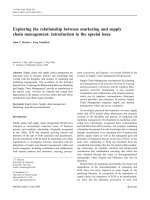ERP supply chain management
Bạn đang xem bản rút gọn của tài liệu. Xem và tải ngay bản đầy đủ của tài liệu tại đây (2.34 MB, 45 trang )
ERP Supply Chain Management: Production
Planning, MRP, and Demand Management
Agenda / Lesson Summary
Problems at Fitter Snacker
Production Planning
Sales Forecasting
Sales & Operation Planning (SOP)
Inefficient SCM in a Nonintegrated System
Production Planning in an ERP
System
How M/S Integrates with SCM for
this Process
The importance of
Utilization and
Capacity In SCM
Demand Management
Detailed scheduling
& MRP
Master Production Schedule
(MPS)
What to Make, How Much
to Make, and, When to
Make it?
How much materials to
MRP
Order, and when to
order it?
Case Study:
Focusing on demand
Kellogg Company
and profit, not sales
•
•
•
•
•
•
•
•
•
•
•
•
•
New Terminology
Material Requirements Planning (MRP)
Sales Forecast
Sales and Operations Plan (SOP)
Master Production Schedule (MPS)
Stock Requirements List
Bill of Material (BOM)
Lead Time
Lot Sizing
Demand Management
Sales History
Aggregate
Rpugh Cut Plan
Production Plan
•
•
•
•
•
•
•
•
•
•
•
•
•
Stock out
Safety Stock
Demand Planning
Standard Costs
Standard Costs
Direct Costs
Indirect Costs
Capacity
Purchase Requisition
Purchase Order
Disaggregate
Inventory
Raw materials
Production Overview
To meet customer demand efficiently, Fitter Snacker must:
•
•
•
•
Develop a forecast of customer demand
Develop a production schedule to meet the estimated demand
ERP system is a good tool for developing and executing production plans
Goal of production planning is to schedule production economically
Fitter Snacker’s Production Problems
Fitter Snacker has problems deciding how many bars to make and when to make them
Communication problems
• FS’s Marketing and Sales personnel do not share information with Production personnel
• Production personnel find it hard to deal with sudden increases in demand might cause shortages or
stockout
Fitter Snacker’s Production Problems
Inventory problems
• Production manager lacks systematic method for:
-Meeting anticipated sales demand
-Adjusting production to reflect actual sales
Accounting and purchasing problems
The Production and Accounting Depts. must periodically compare standard costs (normal costs of manufacturing a
product)
with actual costs (overhead and labor)and then adjust the accounts for the inevitable differences
The Production Planning Process
Three important principles for production planning:
•
Work from sales forecast and current inventory levels to create an “aggregate” (“combined”) production plan
for all products
•
Break down aggregate plan into more specific production plans for individual products and smaller time
intervals
•
Use production plan to determine raw material requirements
The SAP ERP Approach to Production Planning
Sales Forecasting
SAP’s ERP system
takes an integrated
approach
Whenever a sale is recorded in Sales
and Distribution (SD) module,
quantity sold is recorded as a
consumption value for that material
Simple
forecasting
technique
Use a prior period’s
sales and then adjust
those figures for
current conditions
To make a
forecast for Fitter
Snacker
Use previous year’s
sales data in
combination with
marketing initiatives
to increase sales
Sales Forecasting (cont’d.)
Sales Forecasting
Previous Year
Jan
5734
Feb
5823
March
5884
April
6134
Promotion sales
May
June
6587
6735
300
300
Previous year base
5734
5823
5884
6134
6287
6435
Growth (3%)
172
175
177
184
189
193
Base projection
5906
5998
6061
6318
6476
6628
Promotion
Sales Forecast
500
5906
5998
6061
6318
6476
7128
Sales & Operations Planning
Sales and Operations Planning
Dec
Jan
Feb
March
April
May
1) Sales Forecast
5906
5998
6061
6318
6476
2) Production PlanPromotion sales
5906
5998
6061
6318
6900
100
100
100
100
524
4) Working Days
22
20
22
23
23
5) Capacity
7333
6667
7333
7000
7667
6) Utilization
81%
90%
83%
90%
90%
NRG A Bars 70%
4134
4199
4223
4423
4830
NRG A Bars 30%
1772
1799
1818
1895
2070
3) Inventory
100
Sales & Operations Planning
•
In SAP ERP, sales forecast can be made using:
Historical sales data from the Sales and Distribution (SD) module
Input from plans developed in Controlling (CO) module
•
CO module
Profit goals for company can be set
Sales levels needed to meet the profit goals can be estimated
Sales & Operations Planning
•
•
•
•
Rough-cut planning: common term in manufacturing for aggregate planning
Disaggregated to generate detailed production schedules
Once SAP ERP system generates a forecast, the planner can view the results graphically
Rough-cut capacity planning applies simple capacity-estimating techniques to the production plan to
see if the techniques are feasible
Sales and Operations Planning
Sales and Operations Planning
Demand Management
•
•
•
•
Links the sales and operations planning process with detailed scheduling and materials requirements planning
processes
Output: master production schedule (MPS)
Production plan for all finished goods
For Fitter Snacker, MPS is an input to detailed scheduling, which determines what bars to make and when to
make them
Demand Management
Materials Requirements Planning (MRP)
•
Determines required quantity and timing of the production or purchase of subassemblies and raw materials
needed to support MPS
•
Bill of material (BOM): list of the materials (including quantities) needed to make a product
Materials Requirements Planning (MRP)
Materials Requirements Planning (MRP)
Lead times and lot sizing
Lead time: cumulative time required for the supplier to receive and process the order, take the material out of
stock, package it, load it on a truck, and deliver it to the manufacturer
Lot sizing: determining production quantities and order quantities
MRP record: standard way of viewing the MRP process on paper
Materials Requirements Planning (MRP)
Figure 4-17 The MRP record for oats in NRG bars, weeks 1 through 5
Sales and Operations Planning (cont’d.)
• Disaggregating the sales and operations plan
--Companies typically develop sales and operations plans for product groups
--SAP ERP system allows any number of products to be assigned to a
product group
--Sales and operation plan disaggregated
•
Production plan quantities specified for the group are transferred to the
individual products that make up the group
Sales and Operations Planning
Figure 4-11 Product
group structure in
SAP ERP
Sales and Operations Planning
Figure 4-12 Stock/Requirements List for
NRG-A bars after disaggregation
Demand Management
•
•
•
Links the sales and operations planning process with detailed scheduling and materials requirements planning processes
Output: master production schedule (MPS)
Production plan for all finished goods
For Fitter Snacker, MPS is an input to detailed scheduling, which determines what bars to make and when to make them









